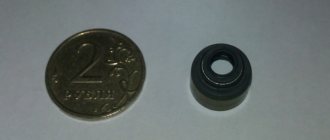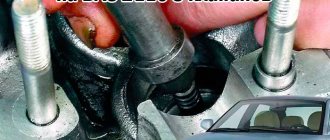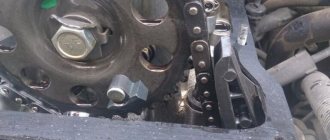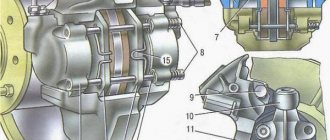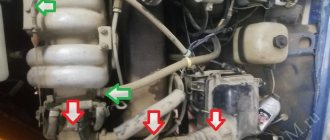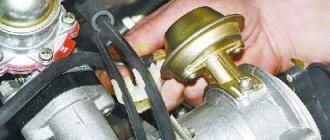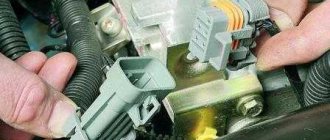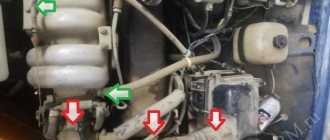To ensure the flawless and safe operation of any vehicle, it is necessary to maintain the ideal technical condition of all parts. Including the smallest ones, which at first glance do not seem too important.
An example of the latter is the valve stem seals, which are used in the design of VAZ engines and ensure its tightness in the contact areas of the guide bushings and valves.
These parts consist of several elements - a powerful bushing, which is made of high-strength steel, a rubber shell that acts as a seal, and expander springs that fix the valve stem and the edge of the cap itself. The weak link of the design is the rubber body, which cannot withstand exposure to aggressive environments for a long time, gradually hardens and is subject to wear. This is what causes engine oil to leak into the combustion chamber.
The main and only symptom that indicates a malfunction of the valve stem seals is the appearance of blue smoke from the exhaust pipe. At the same time, there may be a strong increase in lubricant consumption, so it is better to immediately install new parts so as not to aggravate the problem.
How much does such a procedure cost in a car service? Its price is low, but if you frequently replace caps, your costs can increase significantly. Therefore, it is better to use the instructions below and carry out the replacement yourself. Moreover, it is not at all as difficult as it may seem to an inexperienced car enthusiast.
Device
Oil seals are a modern version of valve seals, which are equipped with a powerful steel sleeve inside and an expander spring. Springs are used to secure the edges of the caps and valve stems.
Actual size of the caps
Gaskets are made primarily of rubber, which becomes harder over time and wear occurs, so the element ceases to properly perform its functions. As a result, oil ends up inside the combustion chamber.
There is only one sign of wear on the valve stem seals - thick blue smoke begins to actively pour out of the exhaust pipe, plus oil consumption increases.
There is only one solution to this situation - replacement.
Oil seal replacement tool
So, before approaching the car, prepare everything you need:
- cap remover - if you don’t have one, you can do without it;
- valve desiccant;
- long-nose pliers or tweezers;
- new valve stem seals in the required quantity (equal to the number of valves in the engine), possibly with a small margin;
- magnetic pointer;
- valve cover gasket;
- tin rod;
- flat screwdriver.
When you have all this in your hands, you can proceed directly to the repair work.
Recommendations for troubleshooting
If, when starting the engine, the indicator of too low engine oil level in the crankcase comes on in your car (it is only present in cars with a high front panel; in cars with a low one, the indicator only has an emergency oil pressure sensor), you must first turn off the engine immediately. Then you need to inspect the power unit for leaks. If they are not there, then after 20 minutes you need to check the lubricant level in the crankcase using a dipstick. If the level is normal (between the min and max marks), you should check the oil level sensor. It is located next to the oil filter. It is always much easier and cheaper to replace a faulty sensor than to disassemble the power unit due to an imaginary breakdown.
To replace the caps you will need the following tools:
- a device used to press the caps (mandrel);
- device for compressing valve springs;
- pliers;
- tweezers;
- a tin rod with a diameter of approximately 8 mm and a length of at least 20 cm.
In addition, a standard set of keys will come in handy.
How to know when it's time to change
Worn caps of a VAZ 2109 car
It's simple: if thick bluish smoke comes out of the car's exhaust pipe, then it's time to change the caps . As a rule, this smoke appears only when the engine starts and when it stops. But if the caps are very worn, thick smoke constantly comes out of the chimney.
However, smoke is not the only sign that the caps need to be urgently replaced. Sometimes smoke is practically not visible, but oil consumption in the car increases several times, while no external oil leaks (through various oil seals and gaskets) are observed. All this also suggests that it’s time to change the caps.
When do you need to change seals?
The fact that they have fallen into disrepair is evidenced by:
- high oil consumption, with no signs of leakage;
- increased fuel consumption;
- traces of grease on the spark plug contacts.
Moreover, the last point is the most reliable evidence of oil seal failure for the simple reason that there is simply nowhere else for the oil to appear.
Regardless of whether you have an injector or a carburetor in your car, the seals are changed in the same way. The only thing that owners of the latter should know is that before starting work you will need to first dismantle:
- gasoline pump;
- Air filter;
- generator drive housing;
- distributor.
How to replace valve stem seals on a VAZ-2109
In order to replace the VAZ-2109 valve stem seals as quickly and accurately as possible, you will need a flat screwdriver, a special puller, duckbills, a head that allows you to quickly unscrew the spark plugs and a valve sealer. If all the tools are ready, all that remains is to proceed with the procedure, which is carried out in several stages:
- remove the fuel pump, air filter and ignition system distributor to provide free access to the valve stem seals. This stage applies only to those cars that run on gasoline and, accordingly, have a carburetor;
- to prevent a short circuit, remove the negative terminal from the battery;
- remove the gear from the camshaft;
- dismantle the cylinder head cover by unscrewing the corresponding bolts, and also disassemble its rear part;
- disassemble the camshaft from the cylinder head side. After this, we manually rotate the crankshaft so that the piston of the cap being replaced “freezes” in the TDC position;
- Use a special head to unscrew the spark plug from the cylinder head. Instead, you need to carefully insert a tin rod with a diameter of 8 millimeters, which should fit between the piston and the valve. The use of this product makes it possible to avoid lengthy and complex dismantling of the cylinder head;
- dry out the valves, then remove their springs and plates;
- press out the valve stem seals;
- To install new parts, you need to remove the steel springs from them and carefully lubricate the product with engine oil. After this, it will be much easier to press the cap into place;
- install the springs and assemble the cylinder head.
We recommend: Changing the alternator belt on an 8-valve Lada Kalina with your own hands: prices and belt size
During the assembly process, you will need to lubricate the camshaft journals and cams, and be sure to install an oil seal to prevent oil leakage.
The valve stem seals must be replaced immediately after signs of wear are detected. Otherwise, oil getting into the engine can lead to serious damage and, accordingly, to a significant increase in the cost of the repair procedure.
How to replace valve stem seals on a VAZ-2109
The appearance of bluish-blue exhaust smoke in your VAZ-2109 may indicate that engine oil has entered the combustion chambers. Most often this happens due to the fact that the valve stem seals have lost their capabilities. In this case, it is not at all necessary to take the car to a car service; if you know the engine structure, you can easily do everything yourself. The main advantage is the price, because instead of repairing one component, the services often do a major overhaul of the machine. So how to change valve stem seals on a VAZ-2109?
- Choice of caps
- Preparation and tools
- Replacing valve seals
Replacement methods
There are a few basic options you have if the caps stop working properly.
| Option | Peculiarities |
| Let it be as it is | The most unfortunate decision, which can lead to serious consequences, engine breakdowns and huge restoration costs. Do not choose it under any circumstances |
| Contact a garage service station | There are many service stations created on the basis of a simple garage in an auto cooperative. Many people use their services, but we do not recommend that you do so. The prices are not as high as at a good car service center, but the quality of services is appropriate, there are no clear deadlines. Once you give the car away, you may not see it soon |
| Verified car service | A good option for those who do not want to do their own repairs and have enough money for high-quality car maintenance. There is only one disadvantage to this method of repair - high cost. |
| Do it yourself | The option preferred by most domestic car owners. Expenses will only be required for materials. With the right approach, you will make a replacement no worse than any good service station |
When choosing the option to replace the caps yourself, make sure you have sufficient experience and skills. Otherwise, doing the repairs yourself is strictly not recommended.
Replacement
To work on replacing oil scrapers you will need:
- Set of flat screwdrivers;
- Head for removing spark plugs;
- New caps;
- Cap puller;
- Desiccant (for valves);
- Platypuses;
- Rod with a cross section of 8 mm.
Extraction process
Having prepared everything you need, you can start working.
- First remove the air filter, fuel pump, ignition distributor. All this is relevant for carburetor VAZ 2109.
- Some argue that to replace the caps it is necessary to remove the cylinder head. Not true. To get around this step you will need a rod. Next we will talk about how to change oil scrapers without removing the head.
- Remove the negative from the battery.
- Remove the gear from the camshaft.
- When disassembling, try to preserve the key. It is located in a pair of camshafts. Pull it out carefully and there will be no problems.
- Dismantle the cylinder head cover by unscrewing all the bolts located around the perimeter.
- Remove the rear part of the cylinder head cover - the ignition distributor plug. Here you will have to unscrew the 2 nuts securing the ground wires, plus remove the conductor tips from the studs.
- On both sides of the camshaft bearing housing, unscrew the nuts, put them aside, but do not lose them.
- Remove the camshaft from the cylinder head and after that you can dismantle the oil seal.
- Rotate the crankshaft until the piston on which the oil seal needs to be replaced is not at top dead center.
- Using a special head, unscrew the spark plug from the block head, insert a rod prepared in advance with a diameter of 8 mm. Preferably made of tin. Insert the rod so that it is between the piston and the valve.
Spring
- Gently compress the valve springs using a depressurizer.
- Using a platypus or tweezers, remove the valve crackers, and then remove the element.
- Remove the upper plate and valve spring from their seats. Don't forget that there are two springs - upper and inner. Both are subject to removal.
- Press out the oil scraper cap located on the guide sleeve. To do this, you need to install a collet of a special tool on the valve, which is used to dismantle these elements. You can easily find it in any auto store or market.
- Place the bike and hit the bushing with it, then hit the bike with the handles.
- Press the cap off the sleeve and remove it from the collet. Ordinary pliers will help here if you don’t have a special tool.
- Be careful when removing as there is a risk of damaging the bushings. Pull straight up and under no circumstances rotate the element when pressing out.
Remove carefully
- Take new caps and remove the springs from them.
- Drop a little oil on the cap and insert it into its rightful place.
- Press the cap with a tool. Make sure that the element is seated all the way and as tightly as possible.
- Replace the spring you removed.
- By analogy, replacement is performed on all other pistons.
- Replace the spring and valve plate. The valve cotters are mounted into the grooves with a special tool.
- Remove the rod. To make the crackers fall into place, hit the edges of the valve with a hammer. For best effect, arm yourself with a small metal rod and strike through it.
- Be sure to lubricate the camshaft supports and washers with engine oil.
- Replace the camshaft. Don't forget to make sure that the cams of the first cylinder are directed strictly towards the tappets.
- Lubricate the camshaft cams and journals with oil.
- Return the camshaft bearing housing to its position. Also make sure that the guide bushings are in the holes in the bearing housings.
- Tighten the fastening nuts and install the camshaft oil seal.
- Reassemble the unit in reverse order.
We recommend: Causes of oil getting into antifreeze and their elimination
Changing valve stem seals is not as difficult as it might seem at first glance. But if such work raises concerns, contact a trusted car service center.
Replacing valve stem seals for VAZ 2109
VAZ 2109 became a cult car in its time. Appearing on the wave of popularity of the eight, it looked more respectable and impressive. Five doors are still not three. And the engines were installed on it a little more powerful.
Not a Porsche, of course, but one and a half liters before the first modification was enough for the car to confidently do its job. Servicing the Nine, like all VAZ classics, did not cause any particular problems. But there were some nuances.
Features of the VAZ 2109 engine
It differed in design from classic models, which at first caused panic among owners and craftsmen who had to service the new car. As it turned out, there was nothing complicated in its design, but the gas distribution system, transmission, ignition system, and a new carburetor were radically changed. But we soon got used to this. Replacing the valve stem seals of a VAZ 2109 was practically no different from a similar operation on classic models, but there were differences, and we’ll talk about them.
Signs of wear on valve stem seals 2109
Fortunately, replacing oil seals, or valve seals, is not a daily operation and should only be done when necessary or during a major engine overhaul. And the need may arise earlier than we expected. The first signs that you need to spend a couple of hours on the valve stem seals:
- Increased oil consumption.
- Characteristic bluish smoke when changing the engine operating mode.
- The spark plugs are constantly flooded with oil on all cylinders at once.
- Difficulty starting the engine.
If all these signs are present, then most likely you should think about replacing the valve stem seals.
Preparatory process
Before changing valve seals, let's take a brief look at why they are needed and how to buy a human repair kit. Valve seals serve to keep the oil that lubricates the gas distribution mechanism from entering the combustion chamber. If the edge of the oil seal is worn out, then the oil, which is intended to lubricate the valve stem, flows along it into the combustion chamber and burns along with the fuel-air mixture, forming a characteristic bluish smoke. Because of this, oil consumption increases, traction drops and the spark plugs burn out.
When purchasing valve stem seals, be sure to ensure that they are as soft as possible. Otherwise, when heated in the engine, they will overheat and lose their elasticity, and will not be able to efficiently remove oil from the rod. You shouldn’t be guided by the principle “the more expensive the better.” Preference should be given to either branded VAZ kits or their Italian analogues. There will be a difference in price, but not too noticeable.
Stages of replacing valve stem seals
We can’t do it without a special tool, so we’ll immediately prepare:
- Tweezers.
- Desiccant.
- Valve seal remover.
- A flat blade screwdriver.
- Soft metal rod.
- A mandrel for pressing in new oil seals.
Now that all the tools are ready, you can start preparing. To get to the seals, we will need to remove the valve cover, camshaft and camshaft housing. How this is done is a separate story, but in this case all operations are performed simply and do not require recommendations.
After dismantling the camshaft, we will see something like the following:
These are the valve lifters that we need to remove to gain access to the valves and seals. The pushers and adjusting washers must be removed in a strictly defined sequence so that they are not mixed up during assembly. This is important because each pusher has its own thermal clearances, and we can break them by changing the installation order.
Then we follow the instructions:
- We secure the desiccant rail to the near and far camshaft mounting studs.
- We install the desiccant lever in a convenient position so that you can rest against the valve.
- We insert a soft metal rod into the threaded hole for the candles, of course, having first unscrewed them.
- We set the piston of cylinder 1 to the top dead center position.
- We press on the valve, when the crackers are released, remove them with tweezers.
- Remove the thrust washer and both springs to gain access to the valve and seal.
- Using a puller, remove the old oil seal.
- Lubricate the new oil seal generously with engine oil.
- Using the same puller, we press the new oil-coated oil seal onto the seat, only you need to act carefully so as not to damage the working edge of the cap.
We carry out exactly the same operation with the remaining caps and assemble the structure.
The operation is not complicated, does not require special qualifications, only during reassembly you need to lubricate the camshaft beds with fresh engine oil and check the thermal clearances after installation. Watch out for the smoke, and good luck on your journey!
Do-it-yourself replacement of valve stem seals on a VAZ 2109: step-by-step instructions
- De-energize the vehicle by disconnecting the battery terminals.
- Remove the air filter housing, fuel pump and ignition distributor - read how to do this in the relevant articles.
- Dismantle the cylinder head cover, to do this, first remove the clamps and hoses going to it, then, unscrewing the mounting bracket, move the accelerator damper drive cable to the side and, finally, unscrew the 2 bolts securing the cover.
- Unscrewing the necessary nuts one by one, remove the camshaft drive belt cover, and then the gear itself. It is also recommended to remove the key from the shaft to avoid its loss.
- Remove the camshaft from the cylinder head, and the oil seal from the removed camshaft.
- Take out the valve pushers one by one along with the adjusting washers and fold them in the same sequence - this will save you from errors during assembly.
- Turn the crankshaft so that the piston of the first cylinder is in the TDC position.
- Install the desiccant rail by screwing it with nuts to the outer camshaft mounting studs. Then install the desiccant itself so that it can be used to press the first valve.
- Unscrew the spark plug, and insert a tin rod into the hole for it between the piston and the valve - it will not allow the valve to fall down.
- While squeezing the valve springs with a compressor, use a magnetic pointer or tweezers to pull out the valve cotters.
- Carefully release the lever and remove the poppet and 2 valve springs.
- Using a cap puller or pliers, remove the oil seal. How to carry out this stage of work with one or another tool, it is better to look at the practice of more experienced car owners or videos on the Internet, otherwise you risk making a lot of mistakes!
- Remove the spring from the new cap (it will be more convenient to install them separately) and press it onto the valve as far as it will go with the back of the puller, not forgetting to first dip it in fresh oil. Here again, be as careful as possible so as not to damage the surface of the head or the valve itself.
- Next, place the removed spring on the installed element.
- Proceed in the same way with all other valves.
- Return the springs, plates and crackers to their places. Take out the tin rod.
- Then use a metal rod and a hammer to help the breadcrumbs settle into place.
- Apply engine oil to the camshaft bearings and pushrod adjusting washers. Install the camshaft: the cams of the first cylinder should face the direction opposite to the valve tappets.
- Also lubricate the camshaft cams and journals with engine oil. In the area of the outer camshaft supports, seal the cylinder head.
- To complete the replacement of the VAZ 2109 oil seals, assemble all remaining elements in the reverse order of removal.
Replacing valve stem seals on a VAZ 2109 with your own hands
To get the job done as quickly as possible, prepare the necessary tools. Here you will need a standard flathead screwdriver, a socket for unscrewing spark plugs, a cap puller, a valve sealer, an 8 mm rod and duckbills.
Before starting work, perform several preparatory measures - remove the air filter, fuel pump, ignition system distributor, as well as other auxiliary units (these parts must be removed if you have a carburetor engine). As soon as the “road is open”, you can start working.
Some craftsmen claim that replacing valve stem seals is impossible without removing the cylinder head. But that's not true. To get around this rule, you can find a small rod with a diameter of 8 mm and use it correctly (more on this below).
The process of replacing valve stem seals is as follows:
1. Discard the “minus” from the VAZ-2109 power source. This precaution will allow you to avoid accidental short circuits in the electrical circuit.
2. Remove the gear from the camshaft.
3. When disassembling, be very careful and try to preserve the key located in the camshaft groove. To do this, carefully pull it out (often there are no problems with this).
4. Remove the cylinder head cover. To do this, just unscrew the bolts around the perimeter.
5. Remove the rear part of the cylinder head cover (ignition distributor plug). Please note that to remove this part you will have to unscrew a couple of nuts that secure the ground wires and remove the conductor tips placed on the studs.
6. Unscrew the mounting nuts on both sides of the camshaft bearing housing and set them aside.
7. Remove the camshaft from the cylinder head and immediately after that remove the oil seal.
8. Rotate the crankshaft until the required piston (of the oil seal that is to be replaced) is in the TDC position.
9. Unscrew the spark plug from the cylinder head and insert the prepared tin rod (as we have already said, the diameter should be 8 mm). Install the product so that it fits between the valve and the piston.
10. Now carefully compress the valve springs with a special device to loosen the valve.
11. Using duckbills (you can use tweezers), remove the valve crackers and dismantle the device.
12. Remove the valve spring and the upper “plate”. Please note that there will be two valve springs - internal and upper. Both of them need to be removed.
13. Press out the oil seal, which is located on the guide sleeve. This is not difficult to do - just install a special collet of a tool intended for dismantling the product on the valve.
14. Position the striker and hit the device sleeve with it, and then the handle striker.
15. Press out the oil seal, which is located on the bushing. Now take it out of the collet. If you don’t have a special device at hand, use pliers for these purposes.
Be careful. To avoid deforming the valve bushings, pressure must be applied only upward. In this case, it is prohibited to turn the caps while pressing them out.
16. Take new caps and remove the springs from them. Act carefully so as not to damage the integrity of the products as they pass through the grooves on the valves.
17. Drop a little motor oil onto the cap and install it in the mandrel.
18. Press in the oil seal. Make sure that the device is seated as tightly as possible.
19. Return the previously removed spring to its place. That's all. The work is completed for the first valve stem seal. Similar measures must be taken for other products.
20. Replace the valve “plate” and the spring. Use a special tool to install the valve cotters into the valve stem grooves.
21. Take out the tin rod. For the crackers to take their position, just hit the edges of the valves with a hammer (you can use a small metal rod for this purpose).
22. Lubricate the camshaft bearings in the cylinder head and the pusher washers (again, no special lubrication is needed - regular oil that is poured into the engine is enough).
When to replace caps
It all usually starts like this: after starting the engine, the oil pressure sensor light comes on. The car owner begins to walk around the engine compartment in search of oil leaks and, finding nothing, checks the lubricant level in the engine crankcase with a dipstick. Having made sure that it is not enough, he simply adds the required amount. However, not even a week passes when the car is actively used, before the lubricant disappears again, the VAZ 2109 oil pressure sensor signals again, and adding oxol becomes as commonplace as refueling.
We recommend: How to check the fuel pump: measuring pressure and troubleshooting it yourself
And the reason for increased lubricant consumption is usually that the valve stem seals (VSC), located in the cylinder head (cylinder head), have ceased to perform their function and simply began to let oil into the combustion chamber. The oil seal is designed to control the use of engine oil. The cap fits tightly to the valve, allowing as much lubricant to pass through as is required for normal engine operation. For the manufacture of valve stem seals, special rubber is used, which ages over time, loses elasticity, and its base comes off, leading to the destruction of these parts. As a result, it begins to leak more and more oil, significantly increasing its consumption.
If the vehicle's exhaust gases have a distinct bluish tint, the valve stem seals should be replaced as quickly as possible. Otherwise, subsequently repairing the cylinder head will be too expensive.
Malfunctions of valve stem seals
High quality materials do not guarantee the eternal operation of valve seals; sooner or later, under the influence of negative factors (high temperatures, aggressive chemical composition of oil, etc.), slight wear of a regular nature occurs, which ultimately leads to the fact that these parts can no longer perform their functions fully. The working surface is rubber and over time the structure becomes compacted, as a result of which elasticity is lost and cracks begin to appear. Long-term operation and exposure to an aggressive environment with high temperatures does not have the best effect on the damper spring. Ultimately, all this leads to the fact that the valve stem seals no longer effectively remove oil from the valve stems, and it ends up in the combustion chambers.
When is it recommended to replace valve seals?
| Causes | Subtleties |
| Depending on mileage. | In practice, the service life of oil seals on a VAZ 2109 with an 8-valve engine rarely exceeds 100,000 km. After this, these parts should be changed, even if there is no excessive oil consumption. |
| If the car has not been used for a long time. | Lack of operation will also have a detrimental effect on the condition of the devices. |
| There are cases when replacement is necessary even when the size of the valve stem seals is reduced prematurely. | This is not uncommon for domestically produced components. |
The fact that it is necessary to change the seals is indicated by some characteristic features.
Symptoms of a problem
Since these caps are installed inside the motor, it is impossible to visually assess their serviceability. However, there are a number of signs that may indicate their poor condition.
- The engine begins to consume oil. There are motors for which consumption of 100 grams per thousand kilometers becomes the norm. If you add a liter of oil every week, your engine is definitely consuming lubricant.
- Oil consumption will certainly be accompanied by bluish smoke from the exhaust pipe. You cannot see this at idle, but if you give the engine a good load, then this phenomenon can be seen in the rearview mirror.
This is interesting: Daewoo Matiz coolant thermostat - how to replace?
Causes of wear
At idle speed, the VAZ 2109 crankshaft rotates at a speed of 800 rpm, the maximum speed is 4,500–5,000 rpm. Each valve can perform from 120 to 1,200 working strokes in a period of time of one minute, i.e., lower and rise. Accordingly, each valve stem seal bears a serious load. In this case, one should take into account the aggressive environment in which they are located (high temperatures, chemically aggressive composition of oils, exhaust gases).
With use, the soft rubber part of the valve stem seals loses its original elasticity. And the diameter of the working edges on which the pressure falls decreases over time. The quality of the seals does not matter; even the best parts will need replacement.
How to know when it's time to change
Worn caps of a VAZ 2109 car
It’s simple: if thick bluish smoke comes from the exhaust pipe of the car, then it’s time to change the caps . As a rule, this smoke appears only when the engine starts and when it stops. But if the caps are very worn, thick smoke constantly comes out of the chimney. However, smoke is not the only sign that the caps need to be urgently replaced. Sometimes smoke is practically not visible, but oil consumption in the car increases several times, while no external oil leaks (through various oil seals and gaskets) are observed. All this also suggests that it’s time to change the caps.
The result of worn valve stem seals
When the first signs of wear of parts appear, it is necessary to immediately diagnose the causes of malfunction of the gas distribution mechanism. Including checking the condition of the valve seals. Experienced car enthusiasts who know the structure of the engine are aware of how to check it themselves. Beginners are advised to address this issue to qualified car repair service specialists. Operating a power plant with all signs of wear on the valve stem seals is highly not recommended for a long period of time.
The consequences of operating an engine with such malfunctions are not the most pleasant:
- engine power is significantly reduced;
- unstable operation at idle (stalls);
- “floating” engine speed;
- reduction of compression in cylinders;
- coking (carbon deposits on pistons, spark plugs and cylinder walls).
The appearance of characteristic soot is a serious symptom. Further operation without identifying and eliminating the causes of its occurrence is fraught with engine failure and major (and therefore expensive) repairs.
What are valve stem seals and where are they located?
Valve seals for VAZ 2109
These caps are located directly on the engine valves, in the cylinder head. Another name for these caps is valve seals. Their main task is to prevent excess oil from entering the engine. These caps are made of special rubber. And rubber, even special ones, deteriorate over time and oil begins to flow directly into the combustion chamber of the engine. In this case, it is worth changing these parts.
Sequencing
- There is a striker on the collet. You need to hit it accurately with a hammer. This will cause the cap to crumple and it will be possible to remove it from the collet with pliers.
The oil seal is removed from the guide bushing using a collet
- Once the crackers are removed, the valve plate and its spring are removed.
When the spring is fixed, the valve nuts are removed using medical tweezers
- After this, a tool is installed to decompress the valves and, with its help, the valve spring is pressed.
- After the piston reaches the dead center, the spark plug is unscrewed from the cylinder, and a tin rod with a diameter of 8 mm is inserted into the opened hole. The tip of the rod should be between the valve and the bottom of the piston.
- Now the crankshaft must be turned so that the piston in the cylinder where the caps are planned to be replaced reaches top dead center.
The camshaft is removed, then the oil seal is removed
- First of all, you need to remove the wires from the battery.
- The timing belt is removed.
- The pulley with teeth is removed from the camshaft.
- The wires are removed from the first fastening, and the nuts are unscrewed from the third fastening.
- Four nuts are unscrewed from the front cover, then the nuts from the rear cover are unscrewed (there are six of them).
- Both covers are removed.
- The camshaft is removed.
- The oil seal is removed from the camshaft.
The valve spring is pressed firmly using a collet
- After pressing the valve spring, the crackers can be removed using tweezers.
First, the valve plate is removed, and then the spring underneath it is removed.
- Now, using a collet, you need to remove the oil seal from the guide sleeve.
By hitting the handle with a hammer, the cap is compressed in the collet and removed
- The new cap is pressed into the valve plate, then a spring is installed on it.
- Similar operations are performed with all caps that need replacement.
- After replacement, the cylinder head is reassembled.
DIY video on replacing valve seals on a VAZ 2109
Important points
- After removing the worn cap, you should carefully inspect the walls of the guide sleeve, since any scratch on this wall left by the collet can lead to renewed oil leakage into the combustion chamber and will negate all efforts to replace the cap.
- Before installing new caps, you must remember to remove the springs from them.
- Before pressing in the new cap, the installation site is generously lubricated with oil. This helps to place the cap in place more accurately, without putting extra effort into it.
As can be seen from the article, it is quite possible to replace valve stem seals on a VAZ 2109 with your own hands. The main thing is to be patient, follow the sequence of operations and not make much effort when pressing the new caps into place.
